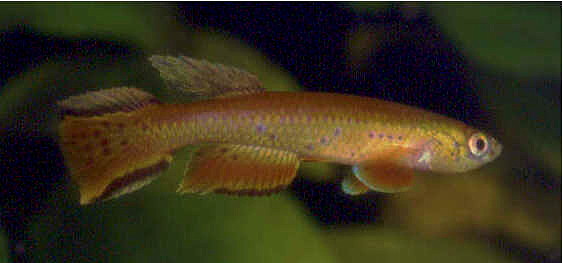

A.congicum. Photo courtesy of Ed Pürzl
| Meaning of Name |
congicus meaning from the Congo. |
||||||
| First Description |
Ahl, E. 1924. Über neue afrikanische Zahnkarpfen der Gattung Panchax. Zoologischer Anzeiger. 60 (3-4), page 307. The original description used material from aquarium stock. |
||||||
| Size |
Males 6 cm, female slightly smaller. |
||||||
| Meristics |
|
||||||
| Karyotype |
n = 15, A = 18 (Scheel 1970, 1971) |
||||||
| Sub-Genus |
Aphyosemion |
||||||
| Group |
elegans |
||||||
| Synonyms |
|
||||||
Populations
|
Vue River - Photo Link DKG |
||||||
| Type Locality |
Exact locality unknown. The only information known is that they were originally caught in the Congo (present day Zaire). The type locality for the synonymised A.melanopteron is given as the Gamba or Gembo River. This is a tributary of the Kwango River which in turn drains into the Zaire River. The exact point of collection was where the Kinshasa - Kenge road passes over the river about 15 km northwest of Takundi (Kwango ferry). The original material was collected by Pierre Brichard who sent them to the USA. |
||||||
| Distribution |
Limited to an area between the Kwango & Gamba Rivers to the southeast of Kinshasa, Zaire. |
||||||
| Habitat |
Rainforest brooks.
Takundi, Zaire, collecting place
of A. congicum Z 17 /82. |
||||||
| Distinguishing Characteristics |
They were known for a time as A.melanopteron
due to the black markings in the dorsal & caudal fins. The sides
are an orange to brown colour with few spots. A fairly easy species
to seperate from others in the group. |
||||||
| Colour/Pattern Variability | Low. | ||||||
| History |
Ahl described this sp. from 13 specimens which were collected by Büttner in the Congo. Ahl's description of the type specimens gives... 'dorsal fin with a very broad blackish band & caudal fin above & below with very broad black borders'. Geoff Wood caught this sp. in January/February 1975 at the type locality, some 180 km from Kinshasa. He also found a population on the same Kinshasa - Kenge road 15 km northwest of Takundi (Kwango Ferry). In the stream the fish were so numerous he easily caught 2 pairs with a small sandwich box. These fish were brought to the UK where they were bred & distributed as A.melanopteron. It was noted that this population was slightly smaller & more intensely coloured than previous imports. A collection was also reported on the Kinshasa - Kenge road where the Lufumi River intersects. The code Aphyosemion CU1 was dropped in 1970 in favour of A.melanopteron (later to become a synonym). Crossing experiments were conducted in 1971-72 where 'melanopteron' was crossed to various members in the elegans group without success. A crossing with A.australe however was regarded as the most successful. Geoff Wood found this sp. on the Kinshasa to Kikwir road east of the Kwango River in 1975. Pat Rimmer reported that a new import came into the UK in 1989 from Holland & had been absent in the UK for several years previous. History of the synonym A.melanopteron. First seen in an import by Aquarium
Imports, New York, USA with others in the group. No location of point
of capture was given which is common in commercial imports. The wild
fish are reportedly described as having broad blackish bands on the
top edge of the dorsal, anal & caudal fin. |
||||||
| Breeding Notes |
Reports would suggest a breeding temperature
of 72'F & no higher. The tank should be put in a shaded area. Rate
of growth for young fish is slow & it may take 6-8 months to reach
sexual maturity. Ian Sainhouse put a breeding report in BKA newsletter
No.149, January 1978 where 2 males & 3 females were put into an
18 x 12" tank with a 1" deep layer of peat fibre at the back
three quarters of the base. Floating plants in the form of Ceratopteris
were used. Rainwater was used with a pH of under 6 & a temperature
of 73°F. In BKA newsletter 289, October 1989 Pat Rimmer wrote a report where he bred them at pH 6 with a constant air flow. They spawned in peat fibre, bottom mops & Java moss. Eggs were water incubated for 15-20 days & were able to take newly hatched brine shrimp. The fry grew very slowly at first & then shot up. Peter Parry in BKA newsletter No.335, August
1993 reports breeding them around 68°F, pH 6 - 6·9, DH 4-6.
He found if the temperature went over 74°F they stopped laying.
Eggs are incubated in cooled boiled water for 16-21 days. Maintain at
70°F & use no chemicals. Fry must not be crowded & thrive
on plenty of water changes. Sex out at 3-4 months & adult at 6. |
||||||
| Diameter of Egg | 1 mm | ||||||
| Remarks |
The photo of Z82 / 17 by Allen Boatman is gold in general colour but Allen informed me that after a diet consisting mainly of newly hatched brine shrimp for 7 months they turned orange. |